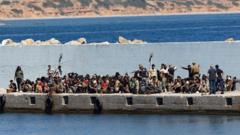As of March 2025, the Trump administration's efforts to house up to 30,000 migrants at Guantánamo Bay remain largely unfulfilled, with only 40 migrants present at the military base. Initial plans saw the Defense and Homeland Security Departments construct tents to accommodate the influx, yet these facilities are currently vacant. The operation is limited to housing just 225 detainees, leaving a significant gap between expectations and reality.
Guantánamo Bay's Migrant Mission: A Halted Process

Guantánamo Bay's Migrant Mission: A Halted Process
After ambitious plans, the migrant operation at Guantánamo Bay shows slow progress, raising questions about its future.
In a span of over a month, fewer than 300 migrants have been transferred from a Texas immigration holding site to Guantánamo Bay. Many who have arrived swiftly return to the United States without clear reasons for their brief stay. The base's capability is constrained, as it can only support around 50 individuals within a small dormitory, while the majority would rely on Camp 6, a former detention facility for suspected terrorists.
Although 195 tents were installed by military personnel and contractors, construction on the expansive tent city came to a halt weeks ago, leaving empty structures as a stark reminder of the unfulfilled strategy. The projected capacity of a massive operation has yet to be realized, and it remains uncertain when or if these plans will materialize. The current status of the migrant mission at Guantánamo Bay underscores the complexities and challenges of immigration enforcement amidst ongoing political and logistical hurdles.
Although 195 tents were installed by military personnel and contractors, construction on the expansive tent city came to a halt weeks ago, leaving empty structures as a stark reminder of the unfulfilled strategy. The projected capacity of a massive operation has yet to be realized, and it remains uncertain when or if these plans will materialize. The current status of the migrant mission at Guantánamo Bay underscores the complexities and challenges of immigration enforcement amidst ongoing political and logistical hurdles.




















